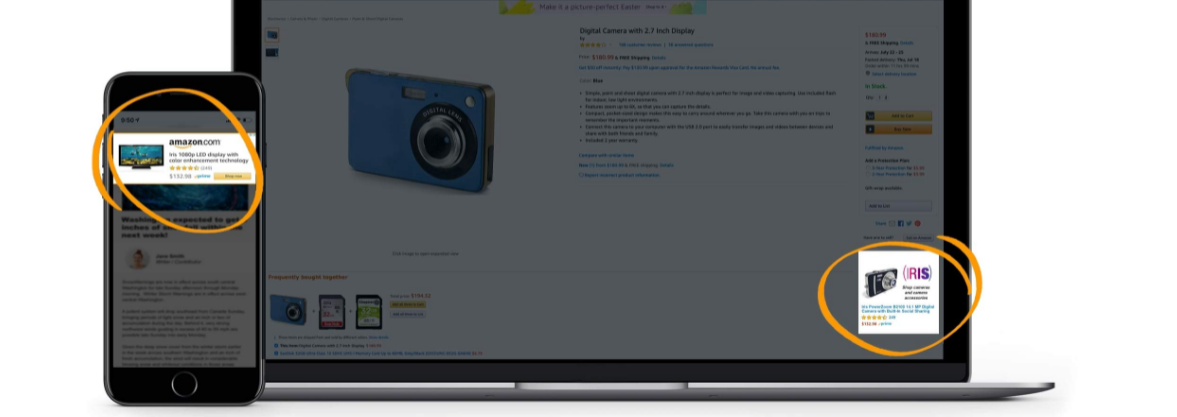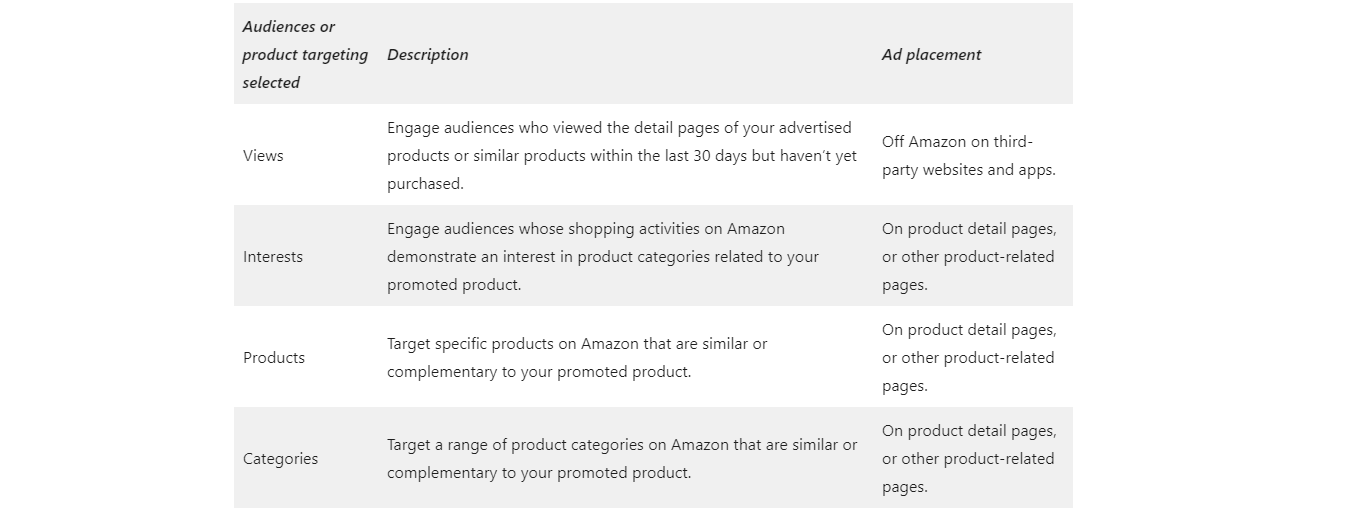Amazon Sponsored Display Ads for Products – What to Know!
Are you using Amazon sponsored display ads? If you’re an eCommerce company currently selling on Amazon you should start. Below we show why, and how to easily get started.
When considering digital marketing channels, Amazon Advertising doesn’t immediately come to mind. Facebook Ads, Instagram Ads, Google Adwords, all hold precedent. But, as it stands, the world’s largest retailer offers one of the best ways to advertise online.
Just consider, on average, businesses who invest their ad spend on Amazon have found:
- $0.97 Cost Per Click (CPC)
- 9.47% Conversion Rate (CVR)
- 34.42% Advertising Cost of Sales (ACoS)
Those routinely best the averages on Facebook and Google’s ad platforms.
A key reason why is because 89% of consumers are more likely to buy from Amazon than other eCommerce sites. As a result, Amazon’s share of US digital ad revenue is on the rise (surpassing 10% in 2020). So if you’re not already using Amazon Advertising, we highly recommend you start.
Amazon Sponsored Display ads are one of the best places to do so, due to their versatility and reach. But before showing how to effectively implement these product display ads, we want to provide an overview of when and why you would use them instead of Amazon Advertising’s other offerings.
How does Amazon Advertising work?
Amazon Advertising is the name of Amazon’s ad platform, and it is used to drive sales of products sold on Amazon via paid promotions.
Every product sold on Amazon has a product detail page (PDP). But a product page can only take your brand so far these days. Amazon’s marketplace has become too competitive for a PDP alone to drive meaningful sales. To truly succeed you need to promote those product pages, both on and off Amazon.
This is done using primarily two methods:
- Pay-Per-Click (PPC) – paying for ads that are clicked on Amazon or third-party sites
- Display Side Platform (DSP) – buying and selling of digital inventory via programmatic advertising
Within those two methods, Amazon Advertising offers a laundry list of ad types and services to promote your brand and product pages. So big is this list that it can easily get overwhelming. Deciding which you should use depends on your business objectives, target audience, and budget.
The majority of advertisers on Amazon utilize three types of PPC ads:
The third type is where we’ll focus our attention today.
What are Amazon Sponsored Display Ads?
Amazon Sponsored Display ads allow you to show an ad for one of your Amazon products to consumers as they surf Amazon AND other websites, targeting people who have previously viewed that product or similar products, used search terms relevant to that product, or purchased other products from you in the past.
They are most often used for retargeting.
Formerly known as Product Display ads, they combine all the ease-of-use of PPC ads with the vast, hyper-targeted reach of Amazon DSP into a single, high-performance ad type.
The difference between Sponsored Display and other Amazon PPC ads
The notable difference between Sponsored Display ads and the other PPC ad types on Amazon — Sponsored Product and Sponsored Brand — is that Sponsored Display:
- Appear to people based on their behavioral actions, rather than keyword searches
- Are not confined to just Amazon, but can appear on external third-party sites as well

The difference between Sponsored Display and Amazon DSP
Amazon DSP is a demand-side platform that lets brands automatically buy ad space at scale across Amazon sites and apps, as well as third-party exchanges, using display and video ads.
The most notable difference between Sponsored Display ads and Amazon DSP is that:
- Sponsored Display ads are purchased on a cost-per-click (CPC) basis, while DSP ads are purchased at higher costs based on format and placement
- Sponsored Display ad creative is generated automatically and cannot be manually optimized, while DSP ads can be modified and fine-tuned
- Anyone with an Amazon Advertising account can self-manage Sponsored Display ads, while DSP ads are usually managed by a buying expert overseeing your ads
How to create Sponsored Display Ads on Amazon
Before being able to run any of Amazon’s PPC ad types — including Sponsored Display — you’ll need to register your brand with Amazon. Once that is set up, you can create a Sponsored Display ad.
To create a sponsored Display ad all you need to do is:
- Log into your Amazon Campaign Manager
- Click “Create Campaign”
- Select Sponsored Display

- Choose your targeting method. There are two types of targeting options available to sellers:
- Views remarketing – based on shopper view history or interests. Targets high-intent audiences who viewed your product detail pages or similar products and categories within the past 30 days
- Product (or Category) Targeting – select if you want your ads to appear alongside specific products or categories, such as a complementary or competitor’s products.
- There is a third option, but it’s only available to vendors: Interests – reach customers who have browsed or shown interested in similar products in a related category over the past 90 days

- Choose the product(s) you want to promote (via the product name or ASIN). You can pick more than one.
- Set a CPC bid
- Add a “Campaign Name,” pick campaign duration, and set your daily budget
- Preview and submit the campaign
Based on your targeting choice and product, Amazon will automatically create your ad (including text and image). They will also decide where to place your ad, with the intent of showing it to people most likely to engage with it.
Where do Sponsored Display Ads appear?
Sponsored Display ads are unique in that they can appear both on Amazon and outside of Amazon. When someone clicks one of your Sponsored Display ads, they are taken to your product detail page.
Display ads appearing on Amazon can be seen on:
- Product Detail Pages (as in the desktop below)
- Customer Review Pages (as in phone below)
- Top of Offer Listing Pages
Most commonly, they are found under the right sidebar’s buying options.

They will also appear on any website owned by or partnered with Amazon, usually in the form of a banner ad.
Where your Sponsored Display ads appear is largely influenced by the targeting method you choose when creating your ad. Here is a placement overview according to each type of targeting:

The benefits of Sponsored Display Ads
So you might be wondering, are Amazon ads worth it? Should you bother incorporating them into your total digital marketing strategy? The short answer is yes! Sponsored Display ads are a super effective means of retargeting — an advertising tactic to reintroduce your brand and products to people after their initial engagement.
Successful retargeting has been proven to:
- Boost traffic by 700%
- Reduce cart abandonment by 6.5%
- Increase CTR by as much as 30%
- Beat other ad placement strategies with 1,046% efficiency rate
So if your goal is to generate more sales than Sponsored Display ads are an absolute must.
Additional benefits include:
- Increase brand awareness
- Promote new products
- Boost traffic to product detail pages
- Poach competitor traffic
- Re-engage existing audiences
- Attract new audiences
On top of helping increase your Amazon sales and rank, Sponsored Display ads can be a great tactic for “full-funnel” advertising. Which means this single ad type can easily be modified to engage every level of your sales funnel — including TOFU, MOFU and BOFU. However, it shines best when targeting people with a strong intent to buy, or who have already purchased one of your products. Which is why we recommend using it primarily to target the lower half of your sales funnel.
Should you use Sponsored Display Ads?
As cool as Sponsored Display ads are, they might not always be the right fit for your advertising goals on Amazon. Ultimately, the decision will come down to a few factors, like where in the sales funnel you want to target.
You should use Sponsored Display if:
- You want to target the lower-half of the sales funnel (i.e. Intent and Purchase)
- You want to retarget shoppers
- You are okay with handing over the reigns to Amazon
You should NOT use Sponsored Display if:
- You want to target the upper-half of the sales funnel (i.e. Awareness and Consideration)
- You want to know where and when your ads will appear
- You want to customize your ad copy and design
A winning Amazon Advertising strategy would be to start with Sponsored Product ads (to generate awareness and target the top of your sales funnel), then follow-up with Sponsored Display ads (to re-engage and drive your audience down the bottom of your sales funnel).
When to hire an agency to help with Amazon’s Sponsored Display Ads
If you’re content with testing to see if you can get any positive results from Sponsored Display, then there’s no need to seek outside help. Just start with a small daily budget. Your returns won’t be amazing, but you’ll mitigate the risk of losing money on unproven display campaigns.
If you’re looking to optimize your Sponsored Display ads to provide a high ROI with far less risk, then you’ll probably want to seek advice from paid media experts. Getting started with Sponsored Display is really easy, but tweaking them to provide the greatest possible Advertising Cost of Sale (ACoS) is anything but.
ACoS is the most important metric on Amazon Advertising. You’ll use it to gauge the success of your ads. The tricky thing is that, depending on your goals, sometimes a low ACoS is preferable and other times a high ACoS is. Knowing when to target each, and how to tweak your ads to get there, is something you’ll probably want some advice on. This way you reduce the risk of wasting your ad spend on unprofitable campaigns.
Here are some things you should ask an agency about:
- Identifying your campaign’s ideal ACoS
- Effectively grouping products into a single campaign
- Figuring out which products should and shouldn’t be grouped together
- Bidding strategies to target specific audiences
- Customizing audiences based on targeting type
Luckily, there are a lot of great agencies out there that specialize in Amazon Advertising and can help you optimize your Sponsored Display ads.
Learn More
Fill out the form below to learn more and to get in touch with our team about how to grow your business on Amazon!
